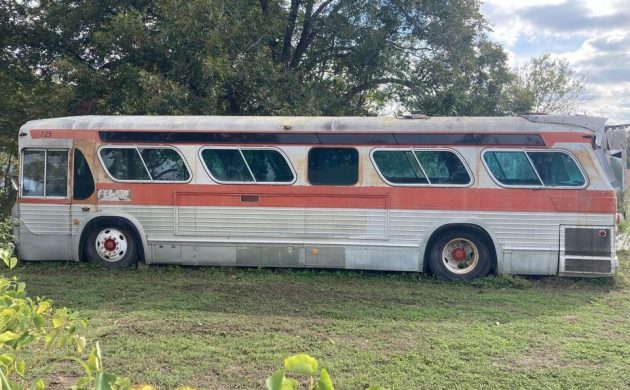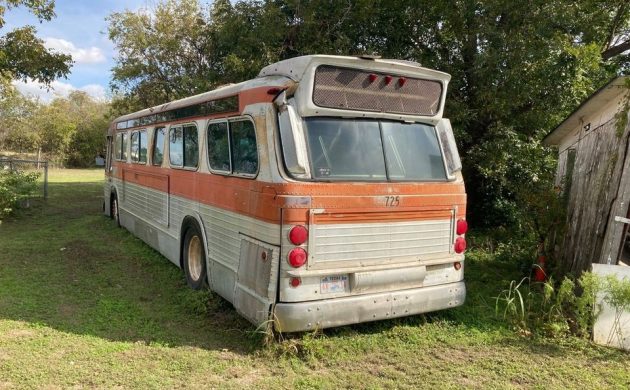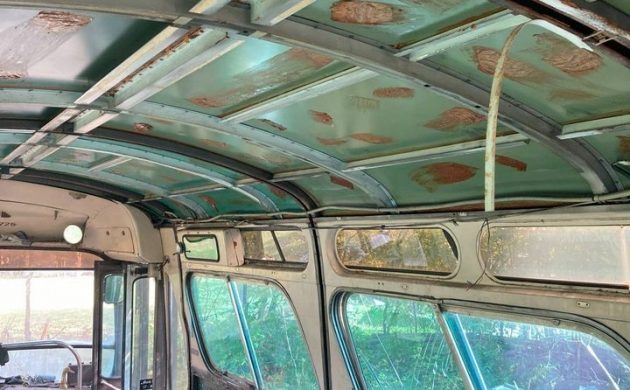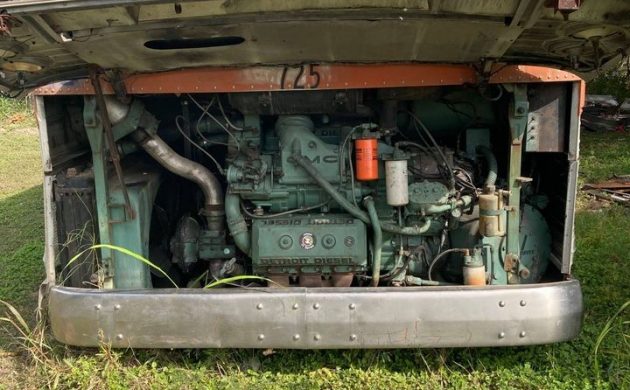It’s funny – in the vintage BMW world, there are all sorts of translations for the different styling eras that emerged in the late 1960s into the 70s. That makes sense, as collectors tend to break their favorite model years into categories based on any number of defining criteria. I didn’t think the same rules applied for something as utilitarian as a bus, but this 1975 GMC motorcoach is classified as being part of the “new look” generation, as it replaced the long-tenured previous generation with a fresh appearance that earned it the moniker of being a “fishbowl” for its multi-pane rounded windshield design. This example retains the original Detroit Diesel engines and if offered for sale by an owner who started tearing into before a job loss changed his plans. Find the GMC here on Facebook Marketplace for $8,550.
It’s amazing to look back and see how striking the designs were for even as generic of a conveyance as a bus. Look at the rake to the rear glass – from the side, it looks like the bus is surging forward. The taillights are also distinctive, in the classic you-can’t-miss-these tradition. The GMC also features extensive glass, which had to have been appreciated by riders. For all we pat ourselves on the back about making natural daylight a regular feature of modern design, it’s clear that today’s interior designers aren’t exactly pioneers when you see what GM’s teams were integrating into an everyday bus.
The seller notes this GMC was running and driving before he parked it. Unfortunately, the batteries were disconnected beforehand and now they’re both dead, with a total cost to replace estimated at $300. The seller notes that between that and the cost to store the bus, he can no longer justify owning it. He did start on disassembly (and it seems like many projects featuring this amount of work done before it gets passed on to the next owner) so as to prep the interior for a conversion of some kind, presumably for a more comfortable living arrangement. He notes that the heater and all piping have been removed along with the interior panels. That’s where the work stopped and where the next owner will have to start from.
What’s most intriguing about this GMC is that its hearty Detroit Diesel engine was rebuilt in 1998. Normally, when we see buses of this vintage come up for sale, they haven’t seen a lick of maintenance in decades. The fact this one had its engine removed and rebuilt indicates someone was still using this vintage people hauler deep into the late 1990s. Was it owned by an enthusiast or a small town that didn’t have the need (or the budget) to upgrade to the next generation model? Either scenario is believable. The bus is located in Austin, Texas, and the seller notes he is open to reasonable offers.






Doesn’t look so new now! I believe these Detroit Diesel 6 cylinders were also used in military vehicles, including the M113 armored personnel carrier.
Is that one of the hi revving screaming Jimmies ? Drove an old gravel truck with one of those. Loud, not that powerful. But reliable
Drove an M113 with this motor back in the day. Obviously sounded just like a city bus, which led us to cut up “State and Main!” before dropping the infantry guys into battle. These were 2 stroke diesel engines with a turbocharger And a roots blower. No they weren’t very fast but then again the vehicle weighed +13 tons!
They really aren’t “high revving”. Most 71 and 92 Series Detroits like this one were set up to run at around 2100 RPM, just as their four stroke competitors were. They only sound as if they’re running fast because every cylinder fires on every revolution, instead of every other.
I think they are “high Revving” because you have to rev the crap out of them and keep it there.This 6v71 will fall on its face at 1500 rpm, where a cummins willl lug along at 600. There is no torque beyond a couple of hundred RPM band. The noise will eat into your cranial matter. I still drive a Kenworth with one today and a couple of hours is all I can take anymore. Don’t know how truckers did it back in the day
Operating range for a stock 71/92 series Detroit of that vintage is 1,800 to 2,100 r/m (governed speed), same for NH/NT/NTC series Cummins except for the NTC-CT engines which is 1,200 to 2,100 r/m. You see how that gear split works on a r/m-mph sawtooth graph.
Fyi trivia: Johnson & Towers and Stewart & Stevenson had 500 HP Detroit 6-71’s turning at 2,800-3,000 r/m.
BR,
“Fyi trivia: Johnson & Towers and Stewart & Stevenson had 500 HP Detroit 6-71’s turning at 2,800-3,000 r/m.”
Were these intended for fire fighting equipment that needed more top speed? Just curious.
@Bill M: J & T and S & S 500 HP 6-71’s were specifically developed for the sports fishing industry’s high end high speed charter boats. Marine application only afaik. As an aside, J & T also offered a twin turbo 3,500 HP “Pursuit” 16V-149 marine engine. None of the aforementioned engines were designed for longevity.
@Jay E: Apparently you don’t know what lugging an engine is. Simply put, it is the engine’s inability to accelerate under a constant load. THIS IS WHY YOU DOWNSHIFT!!!
BR, Thanks for the info, I never knew J & T did marine work too. Their Beltsville, MD location was visible from the British car shop I managed back in the late 1970s, and I remember plenty of fire engines being towed in and later coming out of that shop with new motors.
“New Look”? Funny name for the design of a bus that was put into use in 1959!
The “Old Look” was the 1940 design built through the end of the ’50s (into the ’60s for the less popular sizes) sometimes called the “Rosa Parks bus”.
I went backwards in time, the first city bus I rode on for a kindergarten field trip was one of the city’s first RTS’s in 1979, and later regularly rode a New Look to high school in the late ’80s.
GMC’s reuse of Detroit Diesel engine green for the interior painted surfaces makes it look like one of those toys/models where the interior and engine bay are molded as one piece.
Detroit Diesel’s famous “Alpine Green”. Everyone knows that!
Early “Old look” buses were Yellow Coach TD36’s up until 1943. Late “old look” buses were GM TDH’s when GM bought Yellow Coach.
Rode plenty of them growing up in the 70’s in Boston before it was ‘exact change only’. If you had a dollar the driver had a changemaker clipped to his belt. I’d like to see it restored back as a transit bus. Wonder what happened to the seats?
Just a little bit south of Saskatoon met a little girl her name was June .. .
I drove a M577 in the Army, which is an M113 high rise so one can stand in the area behind the driver. The engine was a V6-71, with the required blower but no turbo.
It’s been over 50 years, but I remember the engine running up to 2300 rpm when driven flat out-which I did a few times.
The engine in this bus could be the larger 6-92.
If you were a kid in a big city in the 60’s/70’s, THIS was how you got around, farther than your 10 speed would go. Bus ridership was huge, everybody took the bus, not just the downtrodden of today. I read, this is still the 6V-71, as the 6V-92 TA ( turbo, this is still a blower), which believe it or not, was a decent motor, came out as an option in 1981. The 4523, I read, is a 35 foot, and a 8V-71 was an option on 40 footers. With the motor sideways, these still used the unique “angle drive” dating back to the 40’s. Unless you plan on some kind of independent bus company, which are failing at a record pace today, a camper is your only option. As popular as these were, over 44,000 were built, I can’t help but think there’s a farm field full of these double stacked somewhere and not $8 grand either. They show up at monster truck shows all the time.
I have seen a picture of a bus that had been converted into a fifth-wheel camper. It looked cool, and was a better end for the bus than a monster truck event… lol
I seriously doubt it was one of these buses. It doesn’t have a frame or chassis. You take out the flooring, which is part of the structural integrity, and it will basically implode.
There very well may be a junkyard full of them some where, but a HUGE number of them have been repurposed, via, the crusher. It is heart breaking for me, as the son of a city bus driver, to see them stacked up or being picked up with the claws to be put in a crusher. I think of my Dad, the many times I road a bus or rode with him. At 69, you may think, you are old enough, get over it. If only it were that simple. I will always miss my Dad, the buses of yesteryear. Life was simpler back then. When compared to much of today, it was the good ole days.
But, in CA and other states which have adopted CA air pollution standards, assuming this engine is pre-1993, whether 2 or 4 stroke, I belive that you can’t register this for use beyond 1000 miles a year without an engine transplant to something newer and less polluting. So beware!
Darn it! There goes the San Francisco to Los Angeles route!
I’d buy this but I don’t think it’ll fit in my garage.
The college I went to had these buses to transport students to different campuses. The oldest one they had was from 1964, and it was this design. They were very old by then. I rode in them a lot. I also remember riding into NYC in the early 80s on one of these. This is also the bus used in the movie “Speed”, which I think came out in 1994. When did GMC stop making buses?
The plant in Pontiac Michigan stopped chruning these out in 1977 and in Canada in 1986.
I see from the destination board at the front, that this bus was from the York, PA and Carlisle, PA areas, so I suggested the seller contact Carlisle Events. They host a big bus/truck event each summer, and this might be a great promotional vehicle for them.
I bought one of these buses in 1992 and converted it into a mobile drop in center for street kids. WAY more work than I ever expected it to be and looking at that interior it just reminds me the incredible amount of work it took to clean it up, refinish it all, install all the furniture, wiring, plumbing, generator, lighting.
Id say the seller is pretty optimistic at that price. The main value is in the engine rebuild but this is a city bus and that transmission is not geared for highway travel so its not like it has a wide range of appeal for anyone looking for something outside of urban travel.
Well it was a transit bus before the church acquired it so that means it has a minimum 500k miles on it most big transit companies would run them to about a million miles and overhaul the engine every 300,000 the transit companies that had more money would dump it at the 500k miles and buy new hope someone has fun with it if you’re skilled at converting to a RV you will wind up with better quality than the $100,000+ tv’s you can go buy today
You should know this. It is the rear end gear ratio that makes or breaks performance. You can have the same basic engine, but with the transmission and rear end ratio different, you will have different results, performance wise.
How do you know it was a church bus before? I do not see anything on the sides to indicate it had been. I only see a number above the engine bay, and the destination sign is not centered.
It said in the Facebook add the seller got it from a church
Someone donated it to a church for the write-off, and the church just flipped it.
I’m a retired transit bus mechanic I worked on more than my share of these, that engine picture brings back a lot of memories they were very easy to work on. Changed a lot of blower drives on the road! They were a well built bus and the bodies held up very well compared to todays buses
I’m thinking that it has air bags if not it might not get over a speed bump…
This bus use to run the streets of my old hometown. I clicked on the facebook pictures and see Lemoyne. So it made it from Pa. to Texas. Long Ride
From what I’ve heard they only stopped running these in 2005 down in the burg. The RTS II’s(the GM models) a few years later. I could be wrong tho.
hummm, plenty of interest (comments anyway). Must B a good pick then?
Not a Ralph Cramden model but a motor from the times. A v e r y famous one.
This could be driven from front OR back…the motor cam B flipped – intake for exhaust, spun. A 2 stroke diesel. Tq but no much speed…
That’s Kramden with a K.
The inline Detroits had multiple configurations, including flat on their sides. Not so much with the V-series even though they could be tilted. Inlines were in production since the mid ’30’s.
Every time I see one of these I think “drive-camper project” unless it’s already been ‘verted into one
Considering (Cumberland and Dauphin) Capital Area Transit ran these till at least 2004…their(GMC ) RTS II’s were retired around the same time .
The memory of riding in them daily is more than enough for me. I would never consider owning a bus, even if I had a band.